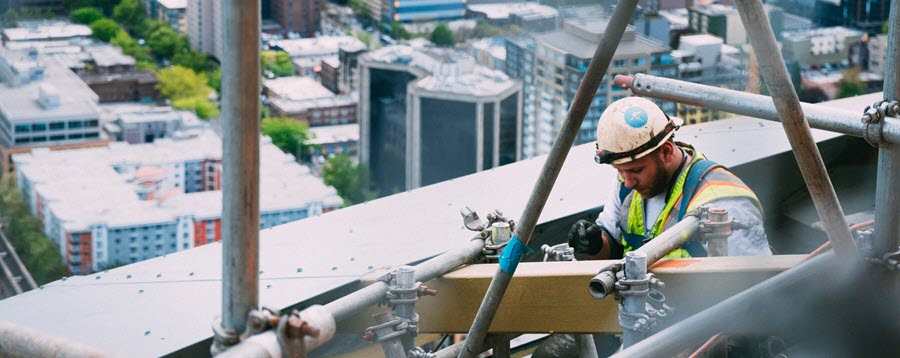
How to Prevent On-the-Job Dangers

Workplace safety is a serious topic for every business and every employee. When workers get injured on the job, businesses can find themselves under scrutiny, potentially dealing with moral and legal challenges. Although this seems like common sense, it’s important to make sure a business is taking proper precautions to protect the well being of its employees as well as the company’s reputation.
High Risk Jobs
Hazardous roles and occupations exist in the workforce. Some are obvious, while others are a bit unexpected. Regardless of the job, every worker should be protected by their employer while on the clock. The danger associated with a specific role often is influenced by job responsibilities as well as the work environment. For example, working at a pet store may not seem risky, but in 2009 it was the highest -risk job – 4 times more dangerous than working in the construction industry. Whether you are a veterinarian, shelter volunteer or run a kennel, it’s important to be aware of the risks that you are facing.
Each job has risks, so it’s important to be aware of the dangers that can be present. Construction work is commonly acknowledged as a dangerous job, but the specific trade (carpenter, mason, etc.) can influence how dangerous a specific role may be. But regardless of the position there are several precautions that should be observed on a daily basis. The most common safety issues on construction job sites include:
- Scaffolds
- Fall injuries (including uneven surfaces, ladders)
- Steel erection
- Excavation
- Hit by equipment
- Electrocution
Aside from these common risks, there can be unexpected dangers too, so safety training and education to keep up-to-date on new techniques and potential new dangers and precautions is vital. In skilled trades, techniques change over the years, and materials that were once used abundantly may later be identified as hazardous. For example, many creative professions once utilized the ancient molding method called lost-wax casting. Oftentimes lost-wax casting used asbestos fibers as a binding agent. Although this technique was used in dentistry predominantly in the 30s, it was used by jewelers and artists as recently as the 1970s. Because of this, those who worked in these professions may be at risk for asbestos-related diseases, including mesothelioma, which is a form of cancer that may not present symptoms for 10-50 years after exposure. Because of illnesses like this, it’s important for employers and workers to be aware of the work you are doing currently as well as the materials you have worked with in the past.
Taking the Proper Precautions
Obviously not all workplaces are the same and some jobs are more dangerous than others. This doesn’t mean safety shouldn’t be considered for every role. From construction sites to working at a desk all day, there are different safety precautions to keep in mind.
Ergonomics
For jobs in an office setting, ergonomics is an important consideration. Ergonomics is the science of designing a workplace to the needs and comfort of a particular employee. Each person will have different needs when it comes to ergonomics, but there are steps that can be taken to benefit the group as a whole. For example, purchasing office chairs with settings and tools that allow them to be personalized to a worker’s exact specifications allows for better posture and thus better overall health – and efficiency – on the job. This may include how a person types, how they hold a phone, what type of mouse they use or other factors that can easily go unnoticed. According to the Occupational Safety Health Administration (OSHA), musculoskeletal disorders, or MSDs, that occur due to ergonomic issues accounted for 33% of worker injury and illness cases.
Repetitive use injuries are another challenge for workers in both offices and job sites. Such injuries are due to overexertion that occurs from repeatedly doing something and causing continuous strain over time. In an office, this may present itself through back pain from sitting at a desk all day, eye strain from continuously looking at multiple screens or wrist discomfort from typing and using the phone. For construction workers, repetitive use injuries can occur due to constant lifting, carrying heavy objects, pushing or pulling. Construction work can be demanding with long hours in difficult environments or body positions that result in continuous strain and long-term injuries.
Knowing the proper precautions to take is important. For an office worker this means standing up from your desk often, ensuring your computer screen is eye level and does not require constant head turning, and considering wearing a headset to take phone calls. For a construction worker, it may be as simple as wearing proper safety equipment such as a back brace, taking several breaks throughout the day, or following the proper safety guidelines presented through frequent training.
Safety Stand-Downs
To ensure safety is top priority, OSHA encourages companies to implement safety stand-downs. A safety stand-down is a voluntary event where employers take a break from their daily duties to discuss potential dangers while on the job, preventative techniques, protective methods and general goals and policies when it comes to safety. Although this is typically encouraged on construction sites, it is something that every company should consider implementing. It’s a smart strategy when trying to raise safety awareness.
Whether working in an office, on a construction site, an art studio or anywhere else, awareness is key to staying safe while on the job.

